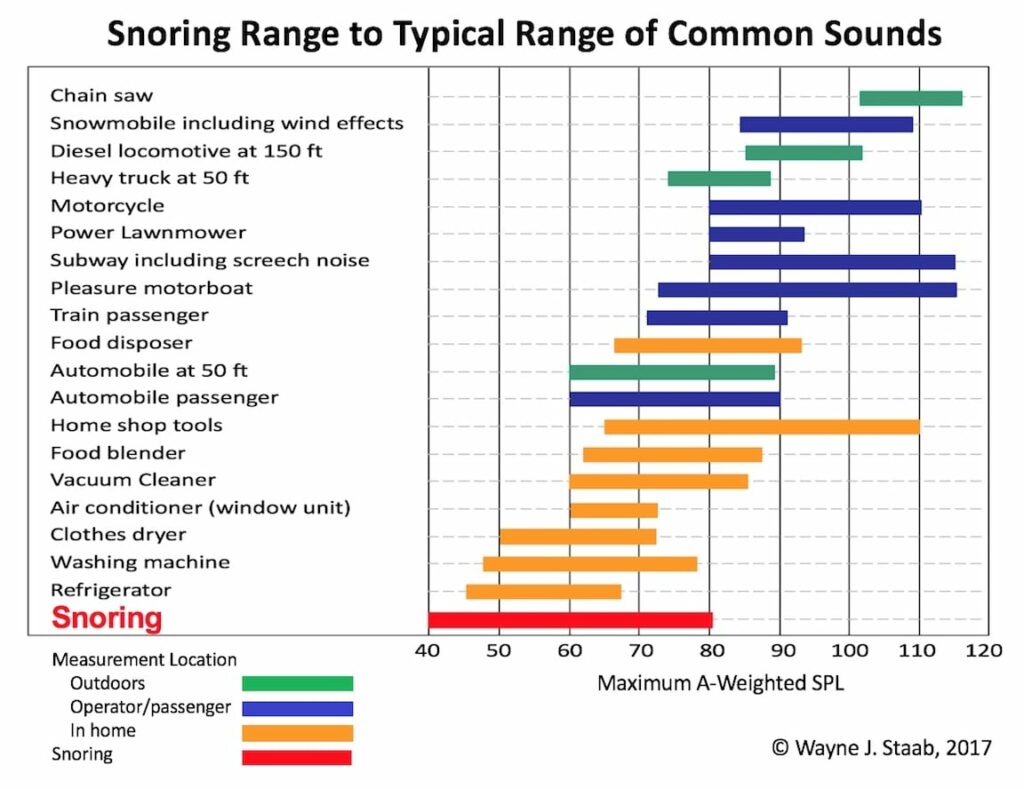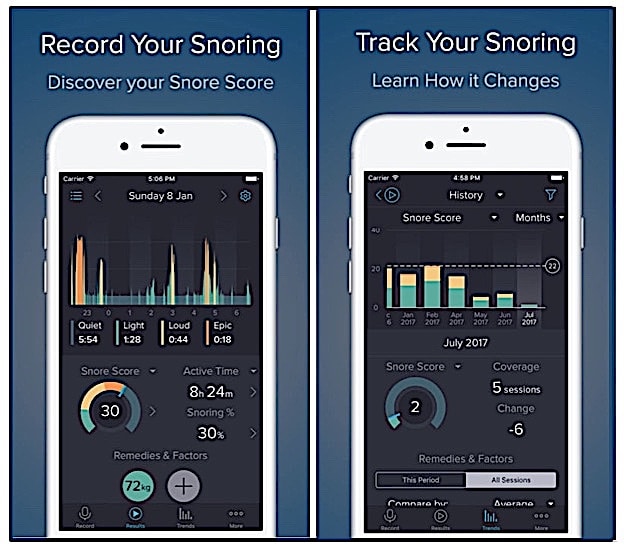An estimated 37 million adults are reported to snore while sleeping as mentioned in a previous post. Loud snoring has been listed as the cause for snorers themselves to arouse from their sleep, and prevent them from having deeper, more restful levels of sleep. However, the effect on bed partners is a major topic of discussion as well, much of it related to the loudness level of the snoring.
Snoring is the noise sound that can be heard when the snorer breathes during sleep resulting from vibrations of the soft palate and uvula against the back of the throat.
How Loud is Snoring?
The range of snoring level ranges dramatically in published articles. Even the “average” level of snoring reported in articles ranges from 50 to 60 dB, with no reference intensity level identified. The range has been shown to be from 40 to just over 80 dBA sound pressure level, and in one case up to 111.6 dB (dB reference level not specified). Unfortunately, most snoring levels cited in non-scientific publications provide little or no information about how the measurement(s) was/were made.
Therefore, the “information” is meaningless. What is worse is the attempt to compare the snoring level to that of other common sounds. This is mostly misleading because some of the common sounds are measured at much greater distances to the measurement microphone than is that of snoring. Figure 1, taken from a previous post shows more realistically the range of snoring to the typical range of common sounds, with the reference level specified.

Figure 1. The typical range of snoring (in red at the bottom of the chart) compared with the typical range of common sounds.
Does Loud Snoring Affect Hearing?
One report states that snoring usually falls between 60 and 80/90 decibels (reference level not specified), and because of this, loud snoring is an indicator for earplugs (assumed to be for the bed partner, but not clearly stated).
On the Liberty Center for Sound Sleep, some of the listed “interesting facts” about snoring related to hearing were:
- Some snorers produce sound that is louder than the decibel level allowed in the workplace, according to OSHA (Occupational Health and Safety Administration).
- The decibel level from snoring can be high enough to cause damage to the human ear.
- Bed partners of particularly noisy snorers have been shown to have a substantial incidence of partial deafness in the ear that faces their snoring bedmate.
- The internal vibration in the inner ear caused by snoring makes the snorer highly susceptible to hearing loss.
In order to qualify each of the above statements, more information would be needed. Care should be exercised when making such statements unless documented data is provided.
Is Hearing Loss to be Expected in Either the Snorer or the Bed Partner?
Interestingly, a number of publications (not all scientific) reference the potential for snoring to exceed the OSHA allowable noise levels for a workplace. OSHA safe noise levels to protect hearing are determined primarily by the amount of noise, the type of noise, and the length of time a person is exposed to noise. Sounds louder than 80 dB SPL are considered potentially hazardous when exposure is for 8-hour days. This normally refers to continuous noise, and not to interrupted noise as snoring is likely to be, an important bit of information required to relate one of the article’s 87 dB (reference noise level not identified) loudest snore to hearing damage risk criteria.
Some snorers are louder than others. But, in spite of this, the average level of about 58 to 68 dBA is unlikely to damage hearing. Of course, the bad news is that such levels may be difficult for bed partners to sleep through.
What About Ear Protection?
Ear protection (most common for sleeping are earplugs that fit into the ear canal rather than something over the ear) is sometimes worn by the bed partner.
For those earplugs having a NRR rating (Noise Reduction Rating), the earplug may not remain firmly in place during sleeping, resulting in less than desirable noise reduction during sleep despite the published noise attenuation number posted. Many earplugs do not have NRR ratings. For sleeping, the use of earplugs is unlikely to perform any protective noise reduction because the snoring level is generally not exceeded to cause hearing loss.
Instead, earplugs are more likely to be worn by the bed partner who is sensitive to the snoring and has a difficult time ignoring it.
Record and Track Your Snoring
For those who are interested in recording and tracking their snoring, an app is available from Reviva Softworks Ltd. It is available for iOS devices. Screen shots are shown in Figure 2. The recording app measures the snore score and the tracking app shows how snoring changes during the sleep period.
Summary
The intensity levels of snoring are realistically not severe enough in the general population to cause hearing loss in either the snorer or the bed partner as some of the more sensationalist articles imply.
Wayne Staab, PhD, is an internationally recognized authority in hearing aids. As President of Dr. Wayne J. Staab and Associates, he is engaged in consulting, research, development, manufacturing, education, and marketing projects related to hearing. His professional career has included University teaching, hearing clinic work, hearing aid company management and sales, and extensive work with engineering in developing and bringing new technology and products to the discipline of hearing. This varied background allows him to couple manufacturing and business with the science of acoustics to bring innovative developments and insights to our discipline. Dr. Staab has authored numerous books, chapters, and articles related to hearing aids and their fitting, and is an internationally-requested presenter. He is a past President and past Executive Director of the American Auditory Society and a retired Fellow of the International Collegium of Rehabilitative Audiology.
**this piece has been updated for clarity. It originally published on November 28, 2017








